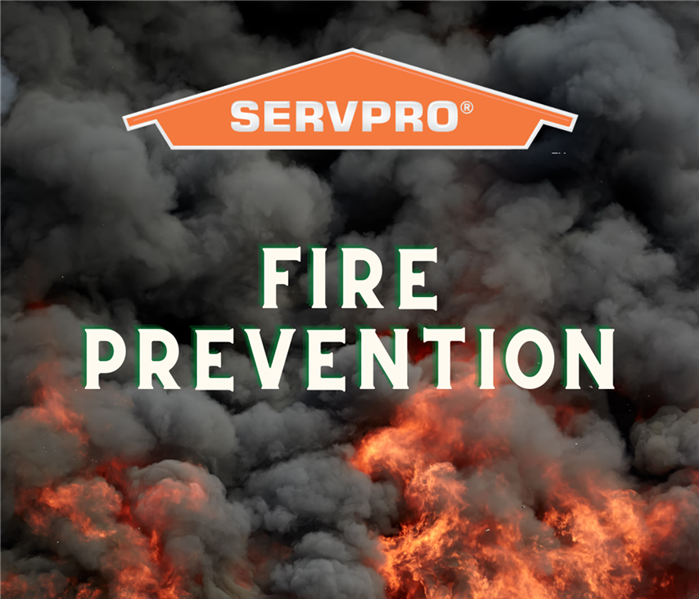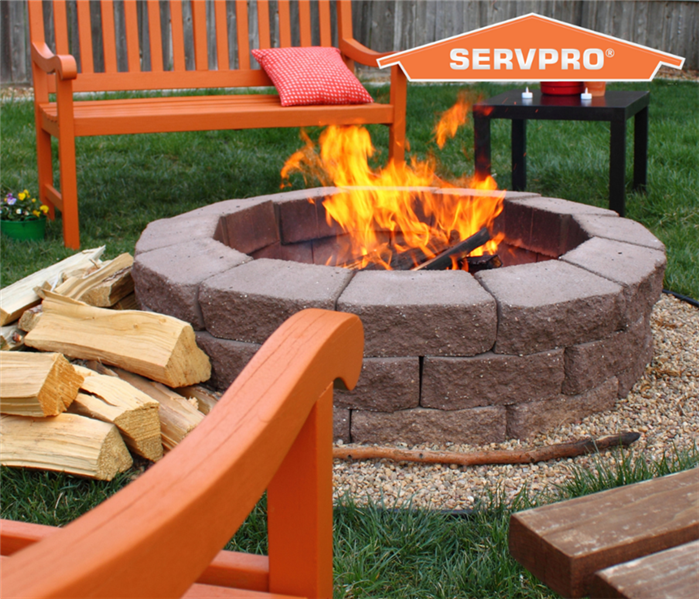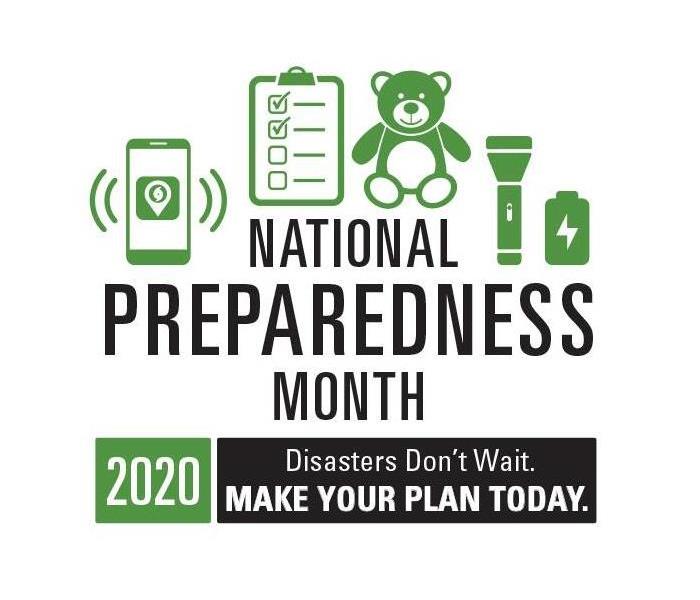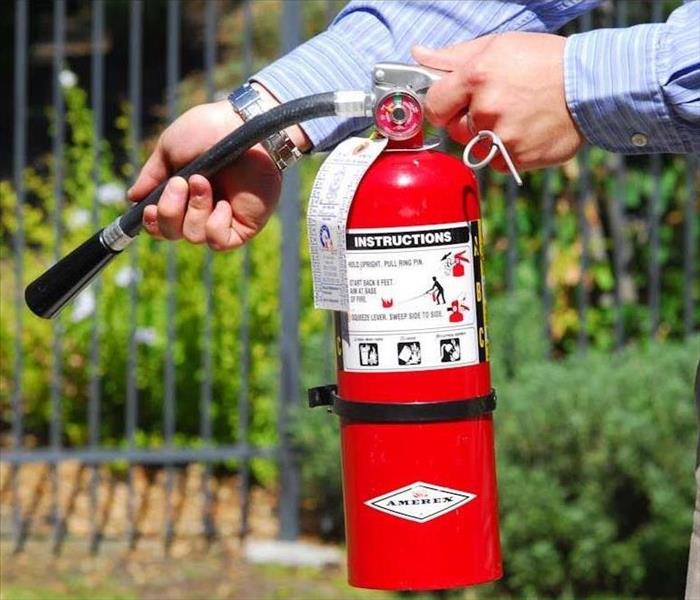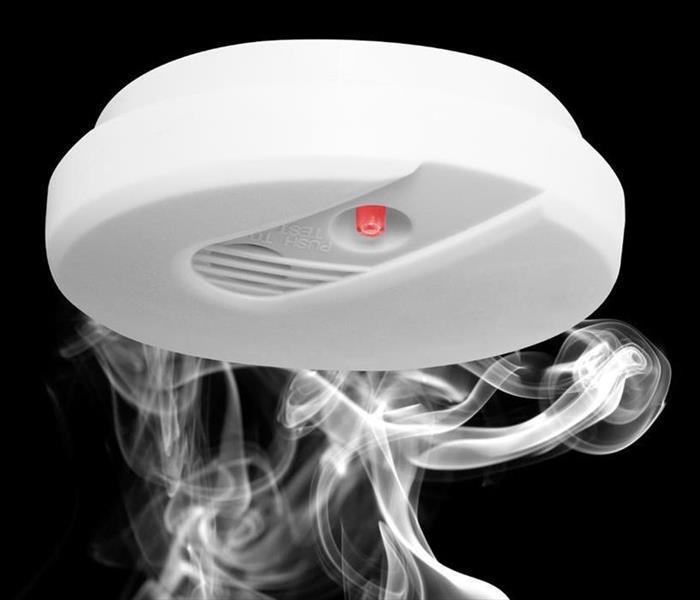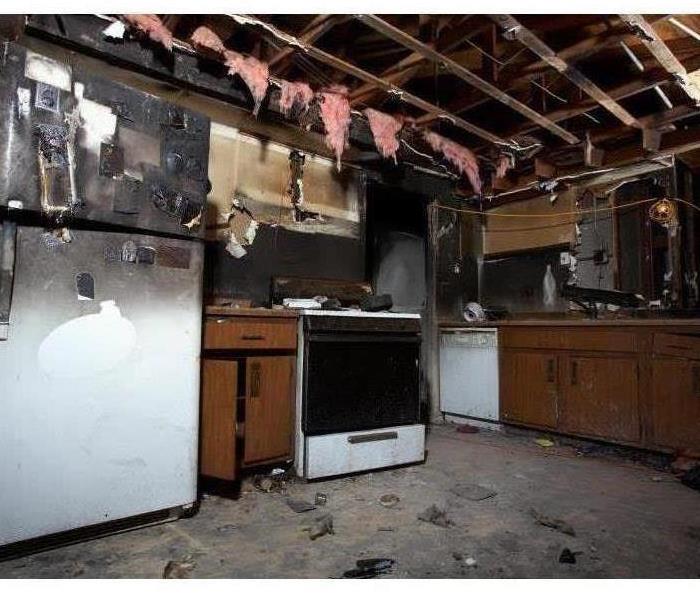Recent Fire Damage Posts
Danger of Candles
2/25/2022 (Permalink)
Candles are an awesome way to light up, add nice decor, or make a home smell like fresh flowers. However, according to the NFPA, from 2014-2018, there were an estimated 7,610 house fires that were started by candles per year that caused an annual average of 81 deaths, 677 injuries, and $278 million in property damage. Save your home with some of these alternatives!
Flame-less candles
For those who just want the aesthetic of a candle and no scent, flame-less candles are a great option! They are typically battery-operated and give the same flame-like feature as real candles.
Wax warmer
Wax warmers are a great alternative because you can get that amazing scent that comes from real candles without the hazard. Warmers are typically either battery or outlet operated to melt the wax.
Diffuser
Calling all of our essential oil fans, this one is for you! With hundreds of combinations to try, diffusers are a great option for the whole house.
Stick diffusers
The most low maintenance option is a stick diffuser. Put your scent in the vase and let the sticks do the work.
If you still plan to opt for a candle, be sure to trim the wick before each use to minimize sparking, place the candle where it can’t fall or be knocked over, and always blow out the candle anytime you leave the room or plan to leave the home.
SERVPRO is a fan of diffusers!
The Danger of Candle Fires
2/6/2022 (Permalink)
Candles are a great way to decorate your home or to add your favorite scent to the room, but they could also be a major fire hazard. Depending on where they are placed they can accidentally be knocked over. It’s also very easy to forget about lit candles if they are in rooms where you can’t keep an eye on them, which could then lead to a fire.
There are lots of candle alternatives in the market today that can help with your decorating and lighting needs for your home, and will help get rid of the risk of fire.
- Battery operated candles. There are so many different options out there with battery operated candles. They can range in sizes from tea lights to large pillar candles, come scented and non scented, flicker like a real candle, and some are even on timers to automatically turn on at the same time everyday. Battery operated candles also come in a variety of colors to fit all your decor needs.
- Candle warmers. Choose from electric bases or larger lamp-style models that are designed to accommodate traditional wax candles. These will warm the wax and help diffuse the fragrance without actually lighting the candle.
- Reed diffusers. Placing reeds in oil is a great way to spread a scent throughout your home without having to rely on an open flame or even a battery operated device
Candles are beautiful and can create such warmth and atmosphere to a home, but can also be very dangerous if not attended to properly. These candle alternatives are great for everyday use in common rooms like kitchens and bathrooms where candles are normally found.
Space Heater Safety Tips
2/6/2022 (Permalink)
With Winter in full swing, many of us are using space heaters to keep ourselves warm. Whether it is at work or at home, space heaters are a great way to stay toasty when the temperatures drop.
When using a space heater however, it is important to follow best safety practices to prevent a fire. Space heaters are perfectly safe, when used properly. Use the tips below and keep your home and office warm and safe, this winter.
- Leave the heater on level floor, don’t place on carpet - it can overheat and start a fire.
- Do not use in bathroom, unless it is designed for it - moisture can damage the heater.
- Keep three feet away from flammable materials and out of the way of children and pets.
- Should always be plugged directly into wall outlet, don’t use with extension cord because it can cause overheating.
- Don’t leave heater unattended, make sure to unplug when not in use.
- Never sleep with a space heater on.
- Install smoke alarms on every floor.
If your space heater shows signs of wear such as broken cords, power fluctuations, or inconsistent temperature, immediately replace. An old space heater can malfunction and start a fire or overheat and leave an odor/smoke smell in the air. Never overuse a space heater and if you smell burning, immediately unplug and discontinue use.
When dealing with frigid temperatures, space heaters are a quick solution to help fight the cold. Using them safely will keep you warm and your office or home safe this winter.
Contents Restoration After Fire Damage
11/8/2021 (Permalink)
Fire damage, including smoke and soot, affects not only the structure of your house, but also your belongings. SERVPRO® understands your family’s furniture, clothing, keepsakes, and other belongings are the very things that make a house a home.
SERVPRO of Hardin/Larue Counties specializes in restoring contents damaged by water, fire, or mold. Our expertise and “restore” versus “replace” mentality can help you save money while preserving precious keepsakes that can’t be replaced. We pretest your belongings to determine what items can be restored to pre-fire condition. We'll use several methods to clean your contents, including:
Dry Cleaning - Used for cleaning light residues or to pre-clean prior to wet cleaning.
Wet Cleaning - An effective cleaning method for removing moderate to heavy residues.
Spray and Wipe -Effective for items that can’t withstand wet cleaning.
Foam Cleaning - Used for upholstery fabrics that might shrink or bleed if wet cleaned.
Abrasive Cleaning - Involves agitation of the surface being cleaned.
Immersion Cleaning - Contents are dipped into a bath of the cleaning product.
Contact us today at (270) 360-0448 for more information!
Don’t Forget P.A.S.S. When Using a Fire Extinguisher
11/8/2021 (Permalink)
The National Fire Protection Association recommends the following when operating a fire extinguisher.
Remember the word PASS:
- Pull the pin. Hold the extinguisher with the nozzle pointing away from you, and release the locking mechanism.
- Aim low. Point the extinguisher at the base of the fire.
- Squeeze the lever slowly and evenly.
- Sweep the nozzle from side-to-side.
For your home, select a multi-purpose extinguisher (can be used on all types of home fires) that is large enough to put out a small fire, but not so heavy as to be difficult to handle.
Be sure to read the instructions that come with the fire extinguisher and become familiar with its parts and operation before a fire breaks out. Local fire departments or fire equipment distributors often offer hands-on fire extinguisher trainings.
Install fire extinguishers close to an exit and keep your back to a clear exit when you use the device so you can make an easy escape if the fire cannot be controlled. If the room fills with smoke, leave immediately.
7 Ways to Prevent a Fire or Smoke
3/16/2021 (Permalink)
7 Ways to Prevent a Fire or Smoke
Dryer Lint
Clean filter each load you dry.
Frayed Cords
Frayed cords can easily combust and turn into a fire. Check for any issues before plugging in.
Safely Store Products
Read labels and make sure to follow them accordingly, as some products are flammable if put near heat.
Fireplace Safety
Make sure the flame is always under control and there is an adult present.
Smoke Alarm Batteries
Regularly test and replace your smoke alarm batteries.
Flammable Kitchen Items
Keep these items away from all heat sources. This includes food and crumbs!
Fire Extinguishers
Have working fire extinguishers in easy to access locations. Also, make sure that anyone in the area that could use one knows how to do so safely!
Space Heater Preventative Fire Safety
2/25/2021 (Permalink)
Space Heater Preventative Fire Safety
Here are 5 preventative measures to take when using a space heater-
- Level Surface
A tipped over space heater can quickly overheat and cause a fire.
- Up to Date Safety Features
Make sure any space heater being used is up to date with the latest safety technology.
- Flammable Materials
Being used close to flammable materials can make them quickly go up in flames if exposed to too much heat quickly.
- Unattended Heaters
TURN OFF WHEN UNATTENDED! Leaving a heater running by itself is a surefire way to cause an emergency. Simply turn off and unplug when leaving the room.
- Children / Pets
Both young children and pets cause a safety hazard when around space heaters. It is best to keep them completely away from any heaters that are on. If it is unavoidable, you can purchase a safety screen that will put a three-foot barrier around the device.
SERVPRO of Hardin/LaRue Counties – 270.360.0448
Fire Prevention
2/8/2021 (Permalink)
As the winter months bring in the cold weather, SERVPRO of Hardin/LaRue Counties know to expect additional calls to come in about smoke and fire damage. These calls can come from both large and small homes and businesses in our area. Many of these issues are caused by the fact that more fire hazards being used to heat both homes and businesses on a daily basis.
Make plans against fire damage today!
Here are 5 ways to help protect your home and business:
- Take out trash regularly to prevent a buildup of flammable materials.
- Have dedicated escape routes for each room of the building.
- Have fire extinguishers available around the office (and home) and check them regularly. Replace ASAP if there are signs of wear and tear or they are empty.
- Install sprinklers or a fire suppression system throughout your business and train all employees on how to disarm them in case of accidental triggering.
- The equipment used in your business can cause problems when not kept clean too. Dirty equipment can easily throw sparks and ignite other items, or the dust buildup can catch flame if sparks come their way.
Fall Safety – Outdoor Fire Pits
11/5/2020 (Permalink)
Fall Safety – Outdoor Fire Pits
Before you plan your next bonfire, review these tips on fire pit safety!
- A fire pit should be at least 10 feet away from anything flammable. It should be at least 25 feet away when it is a muti residential building, such as an apartment building.
- Place seating far enough away from the flames to ensure your guests’ comfort as the flame grows.
- Fire and wind do not mix! If it is windy, wait until it dies down before lighting your fire. A strong gust of wind can easily carry embers to other areas and start other fires.
- Only used approved fire-starting products, do not use flammable liquids (gasoline, lighter fluid, etc.) to light or relight a dead flame.
- The easiest and safest way to start a fire is by using a lighter, paper and some sticks. Use the lighter to ignite a few pieces of crumpled up paper on top of your small pile of sticks. As these catch fire, start adding larger sticks, and then finally, dry logs.
- Wearing loose or flammable clothing while around the fire can potentially cause issues. Taking time to check your outfit can prevent any issues from arising.
- Never leave an ignited fire unattended! Even if it is just for a second, the fire can quickly spread and cause issues. If children or pets are present, keep a watchful eye on them and keep them away from the fire and in safety.
- In case of emergency, have a way to extinguish the fire. This can include a bucket of water, water hose or an extinguisher nearby in case of any emergencies.
- When cleaning up, double check and make sure the fire is completely put out before leaving it for the night. It is good practice to wet down the area, even if you no longer see any flames or embers.
Winter Fire Safety
10/22/2020 (Permalink)
Each winter season, there is an influx of calls that SERVPRO receives asking about smoke and fire cleanup. You may be careful about the risky items or places in the home that cause fire, but are you forgetting anywhere? Here is a list of the top causes of fire losses!
Stove-
This is the highest risk item in your home by far. Even if you are done cooking and it is turned off, it can still cause other items to catch fire if they are sitting too close. Make it a habit of never leaving the stove or oven unattended while still hot.
Other Appliances-
While your stove is the largest threat for a fire, most kitchens are also outfitted with other small appliances that give off heat and can cause other items on the counter to catch fire. While it is tempting to leave these most used items plugged in, it is important to make it a habit of unplugging them.
Candle-
Candles are another household item that can cause issues when left lit and unattended. It is easy for a lit candle to be forgotten about, and items set nearby that can quickly catch on fire.
Lighters –
With this being a common household item, we do not normally think much about them. If there are children in the home or who visit often, it is best practice to store these items in a safe, high place. This prevents any accidents from happening.
Indoor Fireplaces-
A lot of homes have wood fireplaces installed. While these fireplaces are made to contain fire, it is important to remember to only burn dry, seasoned wood. Burning trash or other items can cause flare-ups. This can turn into a house fire or can cause smoke to travel into the home.
If you have any issues this winter season, give us a call for a free quote to make it “Like it never even happened.”
September 2020 National Preparedness Month – Week #4
9/20/2020 (Permalink)
September 2020 National Preparedness Month – Week #4
Week #4 – September 20th-26th, Goal: Teach Youth About Preparedness
Through the month, we have encouraged families to work through activities together, and make sure that your children have been exposed to what you are doing. While it is very important to include them, you may want to take note if anyone gets upset or scared. The goal of being prepared is to help everyone feel more at ease, not scared of anything that could happen. Taking the time and note any negative feelings surfacing, and addressing those could make the difference for your children. One of the best/easiest ways to help ease their nerves is to make sure they understand what to do, and where to find you in any situation. Another plus of working through any scared or negative feelings is that once they are comfortable, they are a lot less likely to freeze up during a real emergency.
Making sure your entire family is comfortable and confident is the goal of this week!
Another great resource to help young children all the way up through the teenage years is www.ready.gov/kids. They not only have a lot of great information for the while family, but they also have age appropriate games for younger children that can help ease nerves. For your older children, they have ways to be involved with the community and get hands on experience for any future disasters. There are also activities for the entire family to do together, which may be a great way to break the ice when talking about these tough topics!
If you are a teacher and are looking for ways to talk to your students about being prepared, use ready.gov as a resource!
Thank you for joining us during National Preparedness Month! Remember to continually update your plans, be proactive, and join us again next year!
September 2020 National Preparedness Month - Week #2
9/6/2020 (Permalink)
September 2020 National Preparedness Month
Week #2 – September 6th-12th, Goal: Build A Kit
After last weeks look at individual needs for each family member, the goal of this week is to build your family emergency kit! The goal of this kit is to help your family survive without assistance for at least three days. Here is a list of items to include in this kit:
Basic Kit Items:
- Water (for each person)
- Food (for each person)
- Hand crank can opener
- Dust masks & cloth masks
- Battery operated radio and/or weather radio
- Flashlights
- Extra batteries
- Wipes
- Local area map
- Cell phone chargers & a backup, portable battery
- First aid kit
- Whistle
- Trash bags
- Wrench & pliers
- Plastic sheeting & duct tape
Additional items to consider including:
- Cash
- Copies of important family documents, in waterproof container or saved electronically
- Disposable paper products
- Prescription & over the counter medication
- Sleeping bag or blanket for each person
- Complete change of clothing for each person (including comfortable shoes)
- Fire extinguisher
- Activities for any children
- Soap & hand sanitizer
- Matches (make sure to store in a waterproof container!)
- Personal hygiene products
- If applicable: Contact lens solution
- If applicable: formula, bottles, diapers, wipes & diaper rash cream
- If applicable: pet food & water
Maintaining Your Home Kit:
Now that your kit is stocked and ready to go, you will need to update and maintain it regularly. It is a good idea to update the kit each time you go over or update your emergency plan you created last week. This ensures it is kept up to date with current family needs, and all items are in date.
Other Kits:
While you are packing your emergency kits, consider making a smaller kit for work, and to keep in your vehicle.
Your Work Kit should prepare you to comfortably stay at work for at least 24 hours. Another note to add is that you will need to include a comfortable pair of walking shoes in this kit, as you may not be wearing comfortable shoes at work when an emergency takes place.
Your Car Kit should be in all cars you may have. The kit should include jumper cables, flares or reflective triangles, an ice scraper, extra cell phone charger (with a car charger port), a warm blanket, map and either cat litter or sand (to help you gain traction if stuck).
Fireworks and Home Fires... What You Need to Know Before July 4th!
6/22/2020 (Permalink)
 Enjoy your 4th of July safely!
Enjoy your 4th of July safely!
An estimated 19,500 fires started by fireworks were reported to local fire departments in the US during 2018.*
Fireworks are a traditional part of most Independence Day celebrations. As beautiful, fun and patriotic as they are; we all know that they can also be dangerous. Here's what you should know before lighting that fuse.....
- Never allow young children to handle fireworks and older children should only use them under close adult supervision.
- Never hold lighted fireworks in your hands or use them indoors. Ensure that all fireworks are aimed away from people, structures, vehicles, trees and brush.
- Never light fireworks in a container of any kind and soak all used fireworks in water before discarding.
- Do wear protective eye wear, maintain a safe distance after lighting and keep a bucket of water nearby to extinguish any malfunctioned fireworks or in case of a fire.
Sparklers
Sparklers burn 2,000 degrees ** and can easily cause clothing, hair and other materials to catch fire. They may also burn you hands or feet if they're not handled properly or dropped. Safer alternatives for children include glow sticks, confetti poppers and colored streamers.
We hope, that with these safety tips, everyone can enjoy a fun and safe fireworks show!
* https://www.nfpa.org/-/media/Files/News-and-Research/Fire-statistics-and-reports/US-Fire-Problem/Fire-causes/osfireworks.ashx#:~:text=Each%20year%2C%20fireworks%20injure%20thousands%20and%20cause%20thousands%20of%20fires.&text=An%20estimated%2019%2C500%20fires%20started,million%20in%20direct%20property%20damage.
**https://www.nsc.org/home-safety/tools-resources/seasonal-safety/summer/fireworks#:~:text=Never%20point%20or%20throw%20fireworks,a%20few%20hours%20before%20discarding
Don't Forget Your Pets When it Comes to Home Safety
6/18/2020 (Permalink)
 Don't Forget Your Furry Friends in an Emergency
Don't Forget Your Furry Friends in an Emergency
Home Pet Safety
Did you know that over 1,000 house fires each year are caused by pets? Our furry friends are curious and don't understand the consequences of fire, but there are measures you can take to keep your family, and your pet, safe.
Keep a Watchful Eye Around Flames
Our pets don't understand that fire will burn them, damage our homes or otherwise cause destruction if not handled properly. Ensure that pets are kept away from grills, campfires and other open flames.
Indoor Fire Sources
Never leave lit candles where a pet could knock them over or burn themselves. This is especially true if you're not in the room. Keep cords neatly bundled, ensure all coating is intact and place them in areas where pets can't access them to play with or chew on them. ALWAYS put out any fire source before you leave.
Include Pets in your Emergency Plans
Some areas now provide window clings (that can be picked up at your local fire department), stating that there are pets in the home. Having one of these can help ensure firefighters find your companion if you're not there to alert them that they're inside.
Keep leashes and cages near entry points for quick access by you or the fire department.
Top Causes of Summer Fires...Protect Your Home Now!
6/8/2020 (Permalink)
Summer is a time of fun, sun and laid back days here in Kentucky. But it can also be a time for fires. Read below to discover the top three causes of summer fires and how to protect your family and home from falling victim to one.
Grill Fires
Grilling can be a fun summertime activity and a family get together favorite. But it can also be a fire hazard. The most common issues with grill fires involve charcoal, coal or broken equipment.
Before grilling, always inspect the grill and ensure that tanks, ignitors and other parts are properly connected and in working order before you start. Also, make sure to clean the grill and drip pans between each use and be aware of your surroundings. Make sure that the grill is placed in a well ventilated area; away from structures and tree branches.
Air Conditioning Fires
During midday, when it's the hottest outside, is an especially high risk time for AC units to catch on fire. This is usually due to the unit or wiring being overloaded by constant operation.
To help prevent this from happening to your AC, ensure that the unit and wiring are in good working order before temperatures heat up. Check around the unit and clear out any materials that could catch fire if the unit does experience a malfunction. Finally, keeping windows and doors closed during the day, running ceiling fans and keeping blinds shut can not only ease the burden on your unit, but may also help lower your energy bills. Win, win!
Fireworks and Chemicals
Fireworks and combustible substances are another source of summer fires. To prevent these fires, handle fireworks carefully and only operate in a safe environment. These should be used according to directions and ignited in an open area, away from structures and trees.
Any chemicals that could be combustible should be moved out of garages, sheds and outbuildings (where the temperatures may rise exponentially) and stored in a cool basement or other area to remove the threat of combustion.
No one wants to experience a home fire. A little preparation and caution is all it takes to better protect your family and your home. But if you do find your Hardin/Larue County home in need of fire mitigation; we're "Always Here to Help". Just give us a call at 270-360-0448.
Help Prevent Your Home From Fire This Summer With These Easy Fire Prevention Tips
6/8/2020 (Permalink)
Summer is a time of fun in Hardin/Larue Counties, but rising temperatures, dry conditions and outdoor cooking can also be the perfect recipe for fire. Here are a few easy steps you can take now to help protect your home and family.
- Check propane grill hoses for leaks, cracks and improper attachments.
- Never store propane indoors
- Always ensure grills are operated away from structures, trees and combustible materials.
- Properly dispose of rags that are oily, greasy or otherwise contaminated with combustible materials. Never leave them in areas that may get hot.
- Keep the area around your house free of dry or dead vegetation.
- Test/Change batteries in smoke alarms and carbon monoxide detectors regularly.
- Test alarms monthly
- Clear garages and outbuildings of garbage, flammable materials and combustible substances.
A little preparation and caution can go a long way from finding yourself in a summer fire. But, if you do experience a fire in your Kentucky home, give us a call at 270-360-0448. We're "Always Here to Help."
Prevention is Key When It Comes to Fires
9/10/2019 (Permalink)
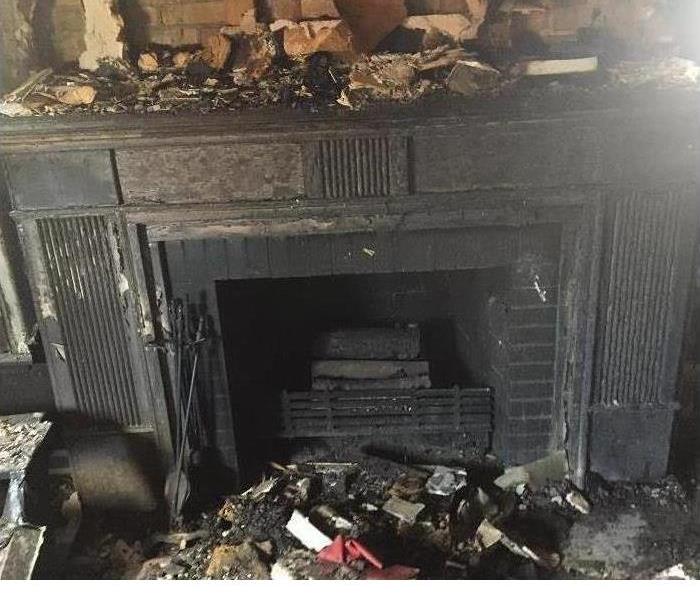 Damage from a fire before mitigation
Damage from a fire before mitigation
Fires will always happen, but we prefer that you personally never have to experience one! If you do, click here for tips on what to do until help arrives.
Fires devastates homes and businesses and cause damage in numerous ways. Not only is fire destructive, but it also leaves behind lingering and pervasive odors. Furthermore, your home or business may also have extensive water damage that results from the firefighter’s efforts to extinguish the flames. The professionals at SERVPRO® of Hardin/Larue Counties have the specialized training, equipment and experience to make it "Like it never even happened".
To increase the odds that you’ll stay safe, consider these common causes of fire. Use this information to plan how to make your home or business a safer place:
- Cooking: Avoid splattering grease, never leave kitchens unattended and keep flammable materials away from heat sources.
- Heating Equipment: Have your furnace checked regularly and keep portable heaters away from combustibles.
- Smoking: If you smoke in or near the house, always make sure the cigarette butt is fully put out and make the bedroom off-limits to smoking.
- Electricity: Look out for frayed cords, the overuse of extension cords and overloaded outlets, and don’t run electrical wires under rugs or heavy furniture.
- Candles: Never leave them unattended and keep them out of the reach of children or pets.
- Children: Keep them away from matches and lighters to suppress any curiosity they may have about what happens when different items burn.
- Inadequate wiring: It’s often found in older homes and apartments. Have a professional electrician check yours.
- Flammable Liquids: Keep fuels, solvents, cleaning agents, thinners, adhesives, and paints away from heat sources.
- Holiday Decor: Keep your Christmas tree well-watered and away from heat sources. Check decorative lights for damage and never place candles on or near Christmas trees.
- Grills: Keep them away from your home, deck rails, tablecloths and tree limbs. And never use them indoors, including your garage.
SERVPRO® of Hardin/Larue Counties has the knowledge, professional equipment and ability to get you back to your life. Besides the easily accessible areas, we also examine wall cavities, duct work, crawl spaces and plumbing chases to establish whether they also suffered any smoke or fire damage. We ensure that all fire damage is cleaned, repaired, or removed and leave your home or business "Like it never even happened".
Clogged Dryer Exhaust Ducts: A Common Cause of House Fires
9/10/2019 (Permalink)
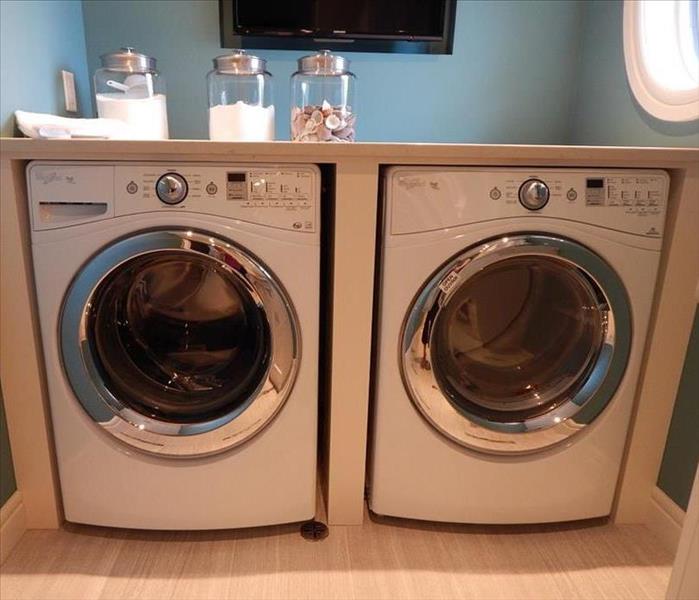 Dryers are a common cause of house fires.
Dryers are a common cause of house fires.
Most of us don’t think about maintenance on our clothes dryers, but we should! The U.S. Fire Administration reports that every year there are thousands of home fires started by clothes dryers. Lint and debris can build up in your dryer vent, reducing air flow to the dryer, backing up dryer exhaust gases, which can result in a fire hazard. It is recommended you have your dryer exhaust system cleaned at least twice a year.
How to tell if you dryer vent is clogged
- Normal drying cycle is not drying clothes
- If it takes more than 40 minutes to dry a load of clothes
- Clothes smell musty after normal cycle
- Clothes are hotter at the end of the cycle
- Large amount of lint accumulates in the lint trap
- Your laundry area is more humid
- Burnt smell in your laundry room
- Outside dryer vent cover is not lifting
What you can do to reduce the risk
- Clean your lint filter after each load of clothes
- Use dryer sheet and fabric softener sparingly
- Remove the back of the dryer to vacuum out lint that is trapped
- Keep area around dryer free of dust and debris
- The duct line that vents outside should be as short as possible
There are tips online on how to clean you dryer vent system, but it is recommended you hire a professional. In addition to the reduced threat of fire, a cleaning can pay for itself in less than a year through the improved efficiency with less drying time required.
SERVPRO of Hardin/Larue Counties is here for you should you do have a loss from a dryer vent fire. Please call 270-360-0448 for help.
"A Fire Won't Happen to Me!"
5/22/2019 (Permalink)
We all feel like it won't happen to us; but it can. Our team here at SERVPRO of Hardin/Larue Counties knows that all to well. We handle multiple fire related losses each year.
How Common Are Fires?
1. U.S. fire departments respond to a call about every 88 seconds!
2. Between 2012 and 2016, there were 355, 400 house fires that resulted in 11,670 civilian injuries, 2,560 civilian deaths and $6.5 billion in direct damages.
3. On average, seven people per day die in U.S. home fires.
What Are the Causes?
Cooking incidents and smoking inside the home have been the most common causes of home fires in recent years. Heating equipment, such as portable heaters, are another common contributor to house fires.
How Do I Protect My Family?
1. Assess your home for possible fire hazards and repair or remove them.
2. Teach all children fire safety.
3. Have a fire safety plan in place. Make sure every family member knows the plan and PRACTICE it!
A home fire is something that we hope you and your family never experience. But, if you do, we're always here to help!
Already experienced a fire loss? Call us today (270) 360-0448 and we'll get started turning your mess into a memory right away!
We're Faster to Any Disaster!
5/22/2019 (Permalink)
Emergencies don't just happen during business hours. Here at SERVPRO of Hardin/Larue Counties, our dedicated team is available to you whenever disaster strikes. As soon as the firetrucks leave, we can be there to start turning your mess into just a memory.
What Happens When I Call?
As soon as you call us, the restoration process begins. A trained representative will gather information from you that will aid our team in responding quickly and coming prepared to do your job efficiently.
What Happens Next?
Once our team arrives, they'll assess the damage to your property and determine the correct course of action. Next, they'll board up any areas that require it and tarp the roof if needed. Once this is completed, the water removal and drying process will start, soot and smoke will be cleaned and your home will be well on its way to being "Like it never even happened."
For a more in-depth breakdown of the fire remediation process visit our fire remediation page.
Simple Steps to Help Prevent a Fire in Your Home
5/21/2019 (Permalink)
1. Don't smoke inside when you're sleepy. This is especially true when seated on a couch or in a bed. Smoking accounts for 24% of home fire fatalities.
2. Don't leave portable space heaters unattended. They account for another 24% of home fire fatalities.
3. Don't leave the room if you're cooking. Stoves and cooking equipment are responsible for another 15% of home fire related fatalities and account for the most common cause of home fire injuries.
4. Make sure matches, lighters and other fire products are put away where young children can't reach them. Children under 5 are eight times more likely to die in a fire caused by playing with these type of products than an older child or adult.
5. Have a plan!
What do you do if you have a fire?
1. Get out! Get out and to a safe place before doing anything else.
2. Have a pre-determined meeting place in mind where firefighters will see you and meet there immediately after getting out.
3. Call 911
4. Account for all family members.
5. Do NOT go back inside.
Does Your Family Have a Fire Escape Plan?
5/21/2019 (Permalink)
Home fires can be devastating. There's something about your hometown that creates a feeling of safety and many people in Elizabethtown, Ky feel like it couldn't happen to them. That all changes when they find themselves in the middle of an emergency. To prepare, every home should have a fire escape plan.
These tips can help you get started.
1. Know Two Ways to Get Out of Every Room
According to the Red Cross, every member of the household should know another way to escape a room if the door is blocked. This often involves climbing out a window. When smoke is pouring in, you don't have time to think. Developing an alternate way out in advance can save your life. Don't forget to include windows as a viable escape option as well as doors as keep an escape ladder in second story rooms.
2. Practice
The faster you move, the better and it can be hard to navigate your route when you're panicked and visibility is low. It's a good idea to practice your escape route a few times a year to make sure every member of your household can escape quickly. This is especially beneficial for younger kids who might struggle climbing out of windows. Consider getting an escape ladder to store in higher level rooms or installing one under your windows.
3. Establish a Meeting Place
Every good emergency escape plan should include a meeting place outside the home, such as a tree or a nearby house. This is a good way to make sure every member made it out safely. From there, you can call the fire department, and a fire restoration company that can begin getting your property (and your life) back to normal.
Developing a fire escape plan is the best way to make sure every member of your household understands how to respond during an emergency. With adequate preparation, hopefully, the only damage during this event will be to your possessions.
Routine Fire Sprinkler Inspections are important to your building's health
9/2/2018 (Permalink)
Of the many tasks assigned to a Maintenance Manager, making sure the building's sprinkler system is in proper working condition is on the top of the list.
Fire suppression during a building fire replies on the sprinkler system doing it's job of containing/eliminating the fire.
Different types of materials within the structure, along with the amount of time the materials were in contact with the fire, will affect the level of damage that a building incurs.
Once the fire is extinguished, knowing how to properly mitigate and repair the building with the various materials in it is important.
If you find yourself needing mitigation for your fire damage give SERVPRO a call today.
Smoke and soot facts:
- Hot smoke migrates to cooler areas and upper levels of a structure.
- Smoke flows around plumbing systems, seeping through the holes used by pipes to go from floor to floor.
- The type of smoke may greatly affect the restoration process.
Different Types of Smoke
There are two different types of smoke–wet and dry. As a result, there are different types of soot residue after a fire. Before restoration begins, SERVPRO will test the soot to determine which type of smoke damage occurred. The cleaning procedures will then be based on the information identified during pretesting. Here is some additional information:
Wet Smoke – Plastic and Rubber
- Low heat, smoldering, pungent odor, sticky, smeary. Smoke webs are more difficult to clean.
Dry Smoke – Paper and Wood
- Fast burning, high temperatures, heat rises therefore smoke rises.
Protein Fire Residue – Produced by evaporation of material rather than from a fire
- Virtually invisible, discolors paints and varnishes, extreme pungent odor.
Our Fire Damage Restoration Services
Since each smoke and fire damage situation is a little different, each one requires a unique solution tailored for the specific conditions. We have the equipment, expertise, and experience to restore your fire and smoke damage. We will also treat your family with empathy and respect and your property with care.
Sometimes your Kitchen just needs to Vent
9/2/2018 (Permalink)
We’ve all been there, it seemed like a good idea to cook the bacon on High heat but that Text from a friend or the person that distracted us from our stove was enough to make it happen.
“It” is that smell that enters your nostrils that makes your hard race as you run to the stove and turn down the heat. As you fan smoke away from the pan you realize you’re spreading this smoke into other parts of the kitchen. You reach for the fan and turn it on for the first time in a while.
Cranking the knob up to high you look over at the smoke detector and the race is on.
“Will the fan suck up the smoke before it gets to the smoke detector and informs everyone in the house you’ve just burned the bacon?”
The Kitchen Fan is mostly a Reactive function in the kitchen. It rarely gets turned on until smoke comes out of a pan or that pot of water starts to fog up the room.
The perfect time to turn on the fan is actually Before you turn on the stove and start cooking. The main purpose of the fan is to eliminate heat and odors from the cooking that you’re doing. The moisture and odors tend to stick to the walls of your kitchen.
The odors and moisture builds up and can turn your kitchen area into a feeding ground for microbial growth.
How do you reduce the chance for moisture and odor issues in your kitchen? Be proactive and turn the Fan on every time you turn the stove on.
If you ever do run into issues in your Home or Commercial building reach out to SERVPRO and we’ll come out and take care of you.
5 Steps To Prepare Your Home for a Fire
5/21/2018 (Permalink)
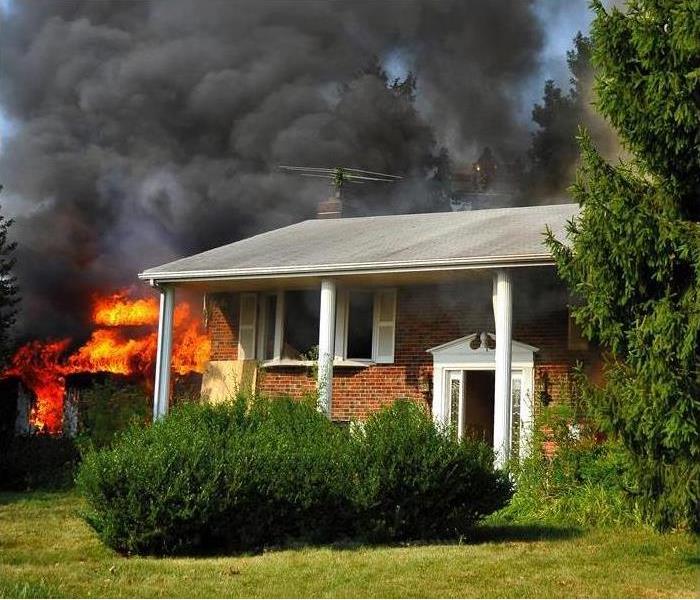
Most people take active measures to prevent house fires, but not many people have implemented fire preparation techniques. Yet, fire prep is just as important as fire prevention, and in fact may be more so when it comes to protecting your home and loved ones. If you have yet to implement fire safety procedures, it’s time to do so. Below are five things you can do to get started:
• Test your smoke alarms.
• Plan an evacuation route.
• Teach your children what to do in the event of a home fire.
• Devise a communication strategy.
• Practice.
Test Your Alarms
Though your smoke alarms should inform you when they’re low on batteries, it doesn’t hurt to check them periodically. Test them once a month, and to err on the side of caution, replace their batteries at least once a year.
Plan an Evacuation Route
This should be at the top of your fire preparation list. Identify all possible exits for each room in the home and make sure that each family member is aware of where those exits are. Designate a family meeting spot outside.
Teach Your Children
If you have young children, show them what the fire alarm sounds like and advise them on what to do if they hear one. Inform them of evacuation routes as well.
Plan a Way To Communicate
Put together an emergency contact list and make sure that all family members know who to contact if they cannot find one another. Have your young children memorize important phone numbers, beginning with 911.
Practice
The best way to ensure that all family members know what to do in the event of an emergency is to practice. Host a fire drill every couple of months and devise different scenarios. In doing so, you can increase the odds that everyone knows what to do and how to escape in a real emergency.
Your SERVPRO fire remediation team or local fire department can review your fire preparation plan and provide additional tips for how to improve it. Don’t cut corners when it comes to fire safety and start planning today.
Tips for Creating a Fire Escape Plan
5/21/2018 (Permalink)
A fire usually happens without warning, so it is important that you are prepared and have a fire escape plan in place before you need it. Knowing how to create an emergency escape plan is the first step, because you want to ensure that the one that you design will be able to get you, your family and your pets out safely and quickly should a fire ever occur.
Fire Alarms
You should have fire alarms outside of all bedrooms and on all levels of the home. This ensures that everyone will be able to hear them sound if a fire happens. Every season, test them and change the batteries so that they are always fresh and working properly.
Prepare and Practice Your Escape Plan
Everyone should play a role in the creation of an escape plan so that they know it. Write it down and put it in an area where people can see it daily, such as on your refrigerator. When you are creating and practicing your plan, give each family member two escape routes. You also want to have a meeting spot for everyone to go to that is safely away from your home.
Once you have a good fire escape plan, it is important that the whole family knows what to do. This means occasionally practicing it, just like the fire drills you used to do when you were in school. According to the American Red Cross, only 26 percent of American families have created a plan and practiced it.
Now that you have this information, it is time to get your fire escape plan in place. Get the entire family together so that you can work on the plan together. It is also a good idea to practice your plan every now and then so that it remains fresh in everyone’s mind.
What to Do When Your Home Has Fire and Smoke Damage
5/16/2018 (Permalink)
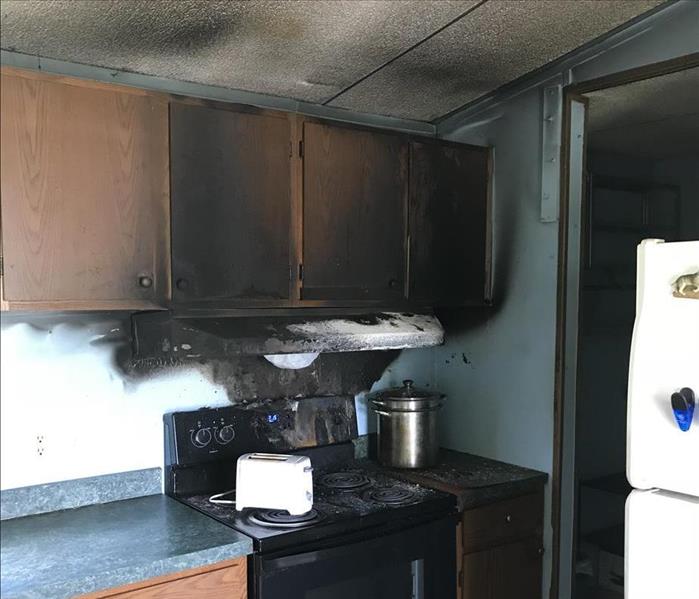 A local stove fire handled by SERVPRO of Hardin and Larue Counties.
A local stove fire handled by SERVPRO of Hardin and Larue Counties.
In a home that has fire and smoke damage, recovery may seem like an insurmountable task. The damage could be extensive, affecting every part of your home. It is important to take these steps when faced with a fire loss to prevent secondary damage. Normal cleaning procedures can increase damage and cause the smoke smell and soot to set into your items. Let SERVPRO of Hardin and Larue Counties take care of you. Our technicians are specialists in dealing with fire damages to help restore your home to its preloss condition.
What to do if your home has fire and smoke damage:
- Limit movement in the home to prevent soot particles from being embedded into upholstery and carpet.
- Keep hands clean. Soot on hands can further soil our home.
- Place dry towels or old linens on rugs, upholstery, and high traffic areas.
- If electricity is off, empty freezer and refrigerator completely and prop doors open to help prevent odors.
- Wipe soot from chrome on kitchen and bathroom faucets, trim and appliances, then protect these surfaces with a light coating of lubricant.
- Wash both sides of leaves on house plants.
- Change HVAC filter, but leave system off until a trained professional can check the system.
- Tape double layers of cheesecloth over air registers to stop particles of soot from getting in or out of HVAC system.
What NOT to do if your home has fire and smoke damage:
- Attempt to wash walls or painted surfaces without first contacting a professional.
- Attempt to shampoo carpet or upholstered furniture without first contacting a professional.
- Attempt to clean any electrical appliances that may have been close to fire, heat, or water without first consulting an authorized repair service.
- Consume any food or beverages that may have been stored close to fire, heat, or water, as they may have been contaminated.
- Turn on ceiling fixtures if ceiling is wet. Wiring may be wet or damaged and cause electrical shock, and air movement may create secondary damage.
- Send garments to the dry cleaner. Improper cleaning may set in smoke odor.
If you have been affected by fire damage, let the pros take care of it for you. Give SERVPRO of Hardin and Larue Counties a call at (270) 360-0448 to get an estimate today. We are always here to help.
What You NEED to Know About Fire Damage
5/16/2018 (Permalink)
Commercial or residential fire damage causes tremendous problems to your business or home. Even if your fire is relatively small, there can be hidden consequences. That's where we come in. As tried, trusted and true fire restoration experts Hardin and Larue Counties, we're here to help you get your home or business back in shape.
Inspection
Before our professionals can begin repairs, we'll survey the property and assess damages. Our inspection is incredibly thorough, so we can provide you with plans for the best path forward. During this time, we'd be happy to answer any and all questions you may have about the fire cleanup process.
Cleaning
Once we complete our inspection, we'll discuss proper procedures and a schedule. Our experts here at SERVPRO of Hardin and Larue Counties will prepare our equipment, close off the area, and make all necessary preparations for cleaning. We'll take care of surface damage by removing burnt sections and damaged items.
Odor Treatment
One of most difficult parts of any fire cleanup job is properly removing the scent in the area. Burnt odors often linger in the air, causing damage to the property's surface on a micoscopic level. We use advanced cleaning technology and products to permanently remove the prescence of all odors in the area.
Final Steps
Once the burnt sections of the property are removed and the odors have been treated, we move on to the last step of addressing the fire damage. If there are any structural damages to the property, we'll either make the repairs ourselves or provide you with the appropriate contact information for other experts who can help. We take our time in addressing each and every detail, because lingering smoke and fire damage can result in future problems.
If you have any questions or need help with fire or smoke damage, contact us 24/7 at (270) 360-0448
Fire Extinguisher - Every Home Needs One
8/17/2017 (Permalink)
A portable fire extinguisher can save lives and property by putting out a small fire or containing it until the fire department arrives; but portable extinguishers have limitations. Because fire grows and spreads so rapidly, the #1 priority for residents is to get out safely.
Fire extinguishers are one element of a fire response plan, but the primary element is safe escape. Every household should have a home fire escape plan and working smoke alarms.
Safety tips
- Use a portable fire extinguisher when the fire is confined to a small area, such as a wastebasket, and is not growing; everyone has exited the building; the fire department has been called or is being called; and the room is not filled with smoke.
- To operate a fire extinguisher, remember the word PASS:
- Pull the pin. Hold the extinguisher with the nozzle pointing away from you, and release the locking mechanism.
- Aim low. Point the extinguisher at the base of the fire.
- Squeeze the lever slowly and evenly.
- Sweep the nozzle from side-to-side.
- For the home, select a multi-purpose extinguisher (can be used on all types of home fires) that is large enough to put out a small fire, but not so heavy as to be difficult to handle.
- Choose a fire extinguisher that carries the label of an independent testing laboratory.
- Read the instructions that come with the fire extinguisher and become familiar with its parts and operation before a fire breaks out. Local fire departments or fire equipment distributors often offer hands-on fire extinguisher trainings.
- Install fire extinguishers close to an exit and keep your back to a clear exit when you use the device so you can make an easy escape if the fire cannot be controlled. If the room fills with smoke, leave immediately.
- Know when to go. Fire extinguishers are one element of a fire response plan, but the primary element is safe escape. Every household should have a home fire escape plan and working smoke alarms.
Article from nfpa.org
Smoke Alarms
8/17/2017 (Permalink)
Smoke alarms save lives. Smoke alarms that are properly installed and maintained play a vital role in reducing fire deaths and injuries. If there is a fire in your home, smoke spreads fast and you need smoke alarms to give you time to get out.
Here's what you need to know!
- A closed door may slow the spread of smoke, heat and fire. Install smoke alarms in every sleeping room and outside each separate sleeping area. Install alarms on every level of the home.
- Smoke alarms should be interconnected. When one sounds, they all sound.
- Large homes may need extra smoke alarms.
- Test your smoke alarms at least once a month. Press the test button to be sure the alarm is working.
- There are two kinds of alarms. Ionization smoke alarms are quicker to warn about flaming fires. Photoelectric alarms are quicker to warn about smoldering fires. It is best to use of both types of alarms in the home.
- When a smoke alarm sounds, get outside and stay outside.
- Replace all smoke alarms in your home every 10 years.
Article from nfpa.org
Fire Restoration Tips
5/16/2017 (Permalink)
After the fire trucks leave, your home likely suffers from fire and smoke damage and extensive water damage from firefighting efforts. SERVPRO of Hardin/Larue Counties have the specialized fire restoration training needed to restore your home to pre-fire condition.
Have Questions About Fire, Smoke, or Soot Damage?
Every fire damage event is a little different, and requires a unique solution, but the general process stays the same. The steps listed below illustrate our process for the “typical” fire damage emergency.
Step 1: Emergency Contact
The restoration process begins when you call the SERVPRO National Call Center, which is staffed 24 hours a day. Our representative will ask a series of questions regarding the fire damage event that will help us dispatch the nearest SERVPRO Franchise Professional with the appropriate equipment and resources.
Step 2: Inspection and Fire Damage Assessment
Our Professionals will carefully inspect and test adjoining rooms of your property to determine the extent of the fire, smoke, and soot damage. This step is crucial to developing a plan of action.
Step 3: Immediate Board-Up and Roof-Tarp Service
Fire damage can often compromise windows, walls, and roofs. To maintain security and to protect against further damage, SERVPRO of Hardin/Larue Counties can board up missing windows and walls and place tarps on damaged roofs.
Step 4: Water Removal and Drying (if water damage is present)
The water removal process begins almost immediately and removes the majority of the water. They will then use dehumidifiers and air movers to remove the remaining water and complete the drying process.
Step 5: Removal of Smoke and Soot from All Surfaces
The SERVPRO of Hardin/Larue Counties use specialized equipment and techniques to remove smoke and soot from ceilings, walls, and other surfaces.
Step 6: Cleaning and Sanitizing
They will clean all of the restorable items and structures that were damaged by the fire. They use a variety of cleaning techniques to restore your belongings to pre-fire condition. They’re also trained to remove odors using industrial air scrubbers and fogging equipment.
Step 7: Restoration
Restoration is the final step—getting your home or business to its pre-fire condition. Restoration may involve minor repairs, such as replacing drywall, painting, and installing new carpet; or it may entail major repairs such as the reconstruction of various areas or rooms in a home or business.
Hardin & Larue Counties Smoke and Soot Clean Up
5/16/2017 (Permalink)
Smoke and soot is very invasive and can penetrate various cavities within your home, causing hidden damage and odor. Our smoke damage expertise and experience allows us to inspect and accurately assess the extent of the damage to develop a comprehensive plan of action.
Smoke and soot facts:
- Hot smoke migrates to cooler areas and upper levels of a structure.
- Smoke flows around plumbing systems, seeping through the holes used by pipes to go from floor to floor.
- The type of smoke may greatly affect the restoration process.
Different Types of Smoke
- There are two different types of smoke–wet and dry. As a result, there are different types of soot residue after a fire. Before restoration begins, SERVPRO of Hardin/Larue Counties will test the soot to determine which type of smoke damage occurred. The cleaning procedures will then be based on the information identified during pretesting. Here is some additional information:
Wet Smoke – Plastic and Rubber
- Low heat, smoldering, pungent odor, sticky, smeary. Smoke webs are more difficult to clean.
Dry Smoke – Paper and Wood
- Fast burning, high temperatures, heat rises therefore smoke rises.
Protein Fire Residue – Produced by evaporation of material rather than from a fire
- Virtually invisible, discolors paints and varnishes, extreme pungent odor.
Our Fire Damage Restoration Services
Since each smoke and fire damage situation is a little different, each one requires a unique solution tailored for the specific conditions. We have the equipment, expertise, and experience to restore your fire and smoke damage. We will also treat your family with empathy and respect and your property with care.
Have Questions about Fire, Smoke, or Soot Damage? Call Us Today!
Why choose SERVPRO for your fire restoration?
5/31/2016 (Permalink)
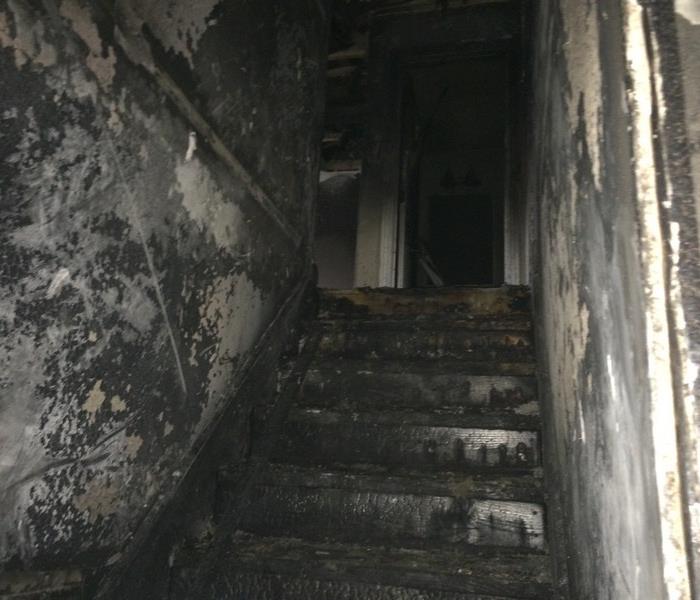 No job is too big or small for our team of professionals.
No job is too big or small for our team of professionals.
Fire Restoration
All restoration projects are unique and require different cleaning methods and processes. These are some steps that we follow to make sure you are receiving the best quality service available for you.
Pretesting
SERVPRO of Hardin and Larue County Professionals start the cleanup and restoration process by pretesting to determine which processes to utilize and allow the customer to preview the results.
Contents Claim Inventory Service
Utilizing Contents Claims Inventory Service technology, SERVPRO of Hardin and Larue County Professionals can generate comprehensive room-by-room inventories. Contents are categorized as salvageable, non-salvageable and questionable-allowing for easier contents settlement.
Cleaning and Restoration
All restorable structure and contents will be professionally cleaned and deodorized to pre-loss condition in most cases. This service includes: walls, ceilings, floors, area rugs, furniture, draperies and upholstery, electronics, art, clothing, bric-a-brac and more. SERVPRO of Hardin and Larue County Professionals can even provide emergency cleaning of contents the customer will need immediately.
Move Outs
If relocation is necessary due to extensive damage, SERVPRO of Hardin and Larue County Professionals are trained to properly move out and control the inventory of contents throughout the cleaning, restorations and deodorization process.
Crews and Equipment
We keep in house the necessary equipment and supplies to clean your home to pre-loss condition. All of our crews are professionally trained and IICRC certified. So you can feel at ease when trusting SERVPRO of Hardin and Laure Counties with you restoration project.
So call SERVPRO of Hardin and Larue Counties for all of your fire restoration needs and feel assured that you will have a team of well trained professionals handling your most valued assets.
Why Professionals Should Clean Smoke Damage From A Fire
5/23/2016 (Permalink)
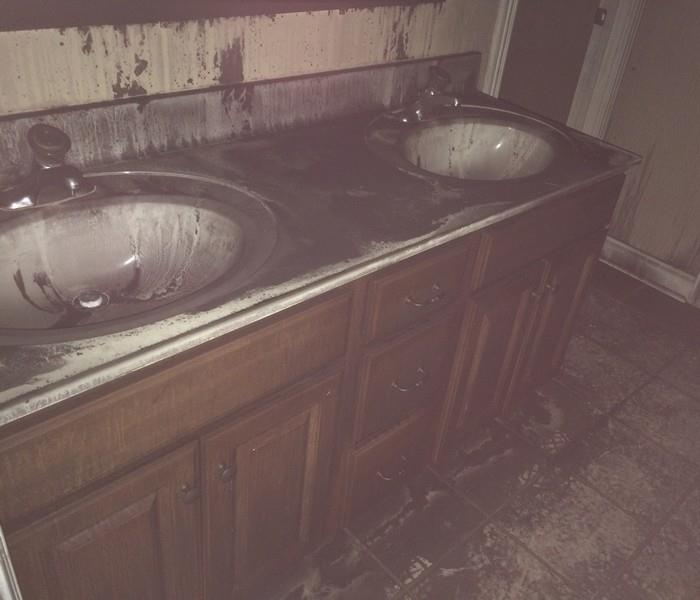 We are certified!
We are certified!
Why Professionals Should Clean Smoke Damage From A Fire
When the firefighters leave, it may seem like the danger has passed and the home is safe from further destruction, but without professionals to help clean the smoke damage, the building will never return to normal. While the principles behind fire restoration are fairly simple, it requires a lot of experience and manpower to perform adequately, and this means that it shouldn’t be attempted by a homeowner on his or her own.
While fire is always the immediate danger, once it is gone, what it leaves behind will continue to affect the house. Ash and smoke, if left unhindered, will cause extensive corrosion, etching and discoloration, not to mention lingering powerful odors. Professionals that clean fire and smoke damage can stop this before it becomes a major problem, assuming they are contacted soon enough. There are many companies out there that advertise their ability to restore areas affected by fire, but only those with proper training and certification should be considered. The Institute of Inspection Cleaning and Restoration Certification (IICRC) is the main oversight agency in this industry. The IICRC requires its registrants to take extensive coursework before earning their certification. This is a symbol of excellence, and those that uphold the standards that have been set can be contacted through the IICRC.
These professionals can clean smoke damage and restore items affected by a fire, but they must be brought to the site as soon as possible to halt the ongoing issues that ash residue can cause. The first thing that ash does to the home is discolor most surfaces. Anything that is made of plastic or was close to the fire will start discoloring within minutes, and within several hours, fiberglass and finishes on appliances will begin to yellow. Metals may also tarnish. After a few days pass, the ash will cause walls to discolor permanently, along with clothing and upholstery. Wood and vinyl will need to be refinished or replaced, and metal will start corroding.
If a professional isn’t hired to clean smoke and fire damage, the costs for restoration will skyrocket after a few weeks. Metals may need to be replaced, carpet will permanently discolor and glass may be severely etched, which will necessitate replacement. It will also become apparent that the odors caused by the disaster may still be present and intense enough to be distracting. Because ash is acidic, the longer it takes to hire experts, the more destruction it will cause.
The first thing a trained, certified, professional company will do when on site is to identify all affected materials and the source of any odors. The only way to properly clean smoke and fire damage is to be extremely thorough. Ash residue is easily disturbed and can spread through the building with ease, causing nearly everything to need restoration. The experts will identify what can and cannot be salvaged, and will remove any built-up ash residue that is coating surfaces. Over time, ash builds up in layers, and may eventually form into a lacquer-like consistency. Once this is done, the restorers will locate the source of the odor, and treat it with specialized detergents that are formulated for neutralizing this kind of odor. Once materials are treated, they may be sealed off to prevent any further odor from permeating the air in the future.
This entire process is very detailed, and hiring a professional that can be trusted to do the job right is imperative.






 24/7 Emergency Service
24/7 Emergency Service
